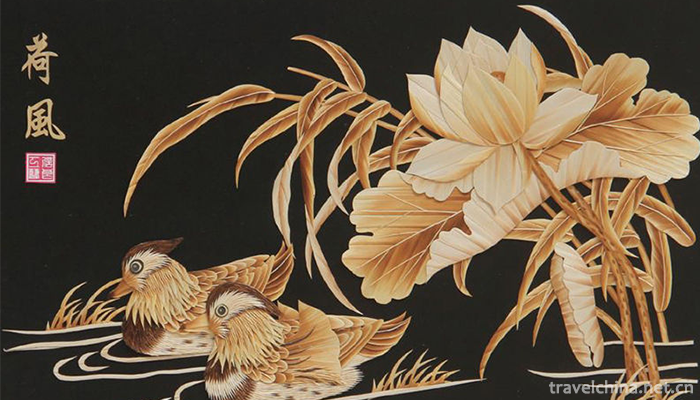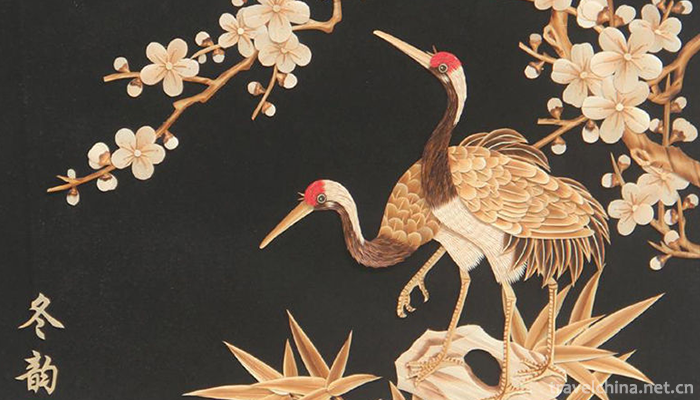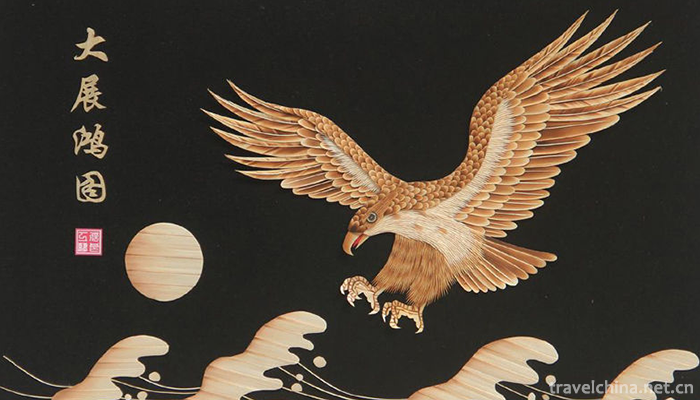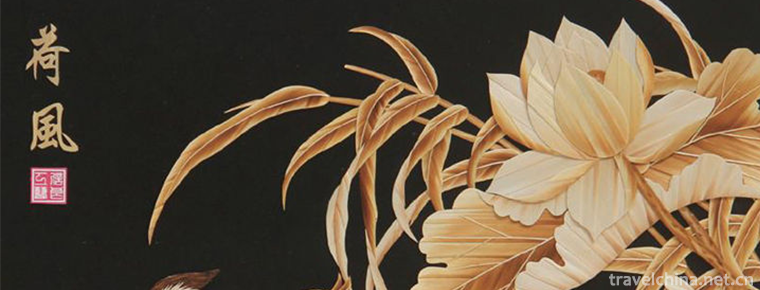Wheat straw cut and paste
Wheat straw cut and paste
Straw clipping is a traditional folk handicraft. Also known as "wheat straw clipping", "wheat straw clipping". Using the natural luster of wheat straw and the characteristics of rushing to tear into silk, the picture is made by blanching or dyeing, using such techniques as tearing, cutting, engraving and rushing, or placing or directly sticking wheat straw layer by layer. Generally, traditional Chinese painting is used in composition. Inserted in the frame, as an appreciation. The wheat straw painting handicraft is produced in many parts of the country. It is famous in Xiantao, Harbin, Chaozhou, Nanyang, Pujiang and Guangxi.
On December 3, 2014, wheat straw clipping was announced by the State Council as the fourth batch of representative projects of national intangible cultural heritage.
Historical origin
Originated in the mid-Ming Dynasty, the traditional craftsmanship at that time came out of the womb from the clipping of wheat stalks and fan stamens, and developed into an independent characteristic craftsmanship in the Qing Dynasty. According to legend, it was first created by artist Ni Renji, and then disappeared for a time. During the Tongzhi period of the Qing Dynasty, folk artist Jin Cui'e excavated and made it popular. Every spring wheat harvest season, folk artists choose the polished straw, which is bleached, dyed and pressed into thin straw sheets, clipped on white silk or cardboard, and pasted (piled) with straw layer by layer to form a picture. Generally, traditional Chinese painting is used in composition. Embedded in the frame, as an appreciation. It also uses straw stickers as dowry ornaments and fan cores.
After the founding of the People's Republic of China, the technology of wheat straw pasting has developed greatly, from a single plane pasting to three-dimensional pasting, such as three-dimensional stacking into goldfish, Mandarin ducks, pheasants, pandas and so on. There are flower arrangement and bookmarks for vases made of wheat straw.
Cutting and pasting of Xiantao straw
Xiantao wheat straw clipping, also known as Deng's wheat straw painting, can be traced back to the Sui Dynasty, has a history of more than 1400 years.
Straw clipping is unique in China and the world. It originated in the reign of Qianlong in Qing Dynasty. It was introduced into Wuyang (today's Xiantao) in the reign of Daoguang. It was widely distributed in Huguang and was the source of wheat straw painting in Wuyang. After more than one hundred years of development, the folk traditional arts and crafts, mainly composed of calligraphy, painting and three-dimensional relief, have gradually formed. Xiantao straw clipping is an important part of Chinese arts and crafts.
After several generations of inheritance and innovation, Xiantao wheat straw painting is mainly created with Jingchu culture as the background and the characteristics of Yumi Waterfront in Hubei Province as the theme. It develops from simple plane carving to semi-stereoscopic and even full-stereoscopic craftsmanship, and uses the advanced craftsmanship to make the works beautiful and environmentally friendly. Deng's wheat straw painting was roughly formed in Tongzhi period of Qing Dynasty. Deng Chuotang (literary elegant Confucian), the grandson of Huguang Wuyang Prefecture, went to the Beijing Palace for an examination. During the waiting list period, he was exhausted. He made wheat straw paintings in the suburbs of the city. The princes and ministers rushed to buy them and gathered in Beijing without envy. Therefore, Jinshi and Ti, in order to edit and polish the painting skills in their leisure time, have become increasingly perfect, forming a unique art secret to their descendants. When the resigned officials returned to their ancestral home, they began to spread in Xiantao, and gradually formed Deng's wheat straw painting, which was adapted to the customs and customs of Xiantao area and popular aesthetics. In 2013, Deng Youpu, the inheritor of Xiantao wheat straw clipping, won the title of Master of Chinese Arts and Crafts.
On December 3, 2014, Xiantao wheat straw clipping was announced by the State Council as the fourth batch of representative projects of national intangible cultural heritage.
Chaozhou wheat straw clipping
Chaozhou wheat straw cut-and-paste art originally appeared in the form of knitted fabrics. Rural artists use newly harvested straw to weave baskets, hats, tables and chairs, sedan chairs, fans, horses and other small crafts. Later, it gradually evolved into wheat straw clipping. The main themes of Chaozhou straw clip paintings are characters, flowers, birds and animals, aquariums and landscapes. There are two forms of expression: natural color and color matching. The true color refers to the golden and brown-red color of wheat straw itself, which is cut and pasted on dark paper lining or thin board, silk and satin. Cross-color is to dye wheat straw in various colors, cut and paste on the thin board, thus producing special artistic effects. The wheat straw cut-and-paste painting has the delicate embroidery of Chaozhou and the charm of Chinese painting, which enjoys a high reputation at home and abroad.
In 2009, it was selected as the third batch of provincial intangible cultural heritage list.
Qingfeng wheat straw clipping
On December 3, 2014, the State Council promulgated the Circular of the State Council on the Publication of the Fourth National Catalogue of Representational Items of intangible cultural heritage (Guofa 59). 153 items of the expanded catalogue of representative items of intangible cultural heritage at the national level were published, of which 18 items in Henan Province were successfully selected. The traditional art straw clipping in Qingfeng County has been published by the State Council as the fourth batch of representative projects of national intangible cultural heritage.
Nie's wheat straw painting is also one of the wheat straw painting varieties with large scale and great influence in the Central Plains area and good heritage and protection of excellent traditional culture. It has high research value in folklore, painting art, folk skills and so on. This is listed in the national protection project list, which will promote the intangible cultural heritage protection of Qingfeng County to a new level, and also make new contributions to promoting excellent traditional culture and promoting the comprehensive and coordinated development of our county's culture, economy and society.
Inheritance significance
The wheat straw painting is named for its material, which is a folk clipping art full of strong local flavor, symbolizing good luck and harvest. Therefore, it has a special meaning, with high ornamental value and collection value.




-
1.China Ejiao Museum
China Ejiao Museum, built in 2002, is located at the foot of Mount Tai, east of Donga County on the Bank of the Yellow River. It is funded by Donga Jiao Group, the largest Ejiao production enterprise
Time 2018-12-22 -
2.Gongchangling Hot Spring Skiing Ground
Gongchangling Skiing Ground is located in Tanghe Scenic Area of Gongchangling, Liaoyang City, Liaoning Province. It covers an area of 100 hectares and is a national AAA-class tourist attraction.
Time 2019-01-12 -
3.Narati Scenic Spot
Narati Tourist Scenic Area, located in Xinyuan County, Xinjiang, is located in the hinterland of Tianshan Mountains, the eastern end of the Ili Valley, with a total planning area of 960 square kilomet
Time 2019-02-07 -
4.Senbora Resort Forest Scenic Area
Senbora, a landscape world in ancient forests, a paradise of pleasure water under glacial ruins, a national 4A-class tourist attraction, is located at the exit of Fogang Expressway in Fogang County
Time 2019-02-07 -
5.Tujia Style Garden
Zhangjiajie Tujia Style Park is located in Zhangjiajie City, a beautiful pearl. The Park covers an area of more than 80 mu with a total investment of 75 million yuan. It is a large-scale
Time 2019-02-22 -
6.Xiaolangdi Yellow River Three Gorges Scenic Area
The Three Gorges Scenic Area of the Yellow River in Xiaolangdi is a world geological park, a National Water Conservancy Scenic area, the most attractive place in China, ten hot spots in Henan Province
Time 2019-02-25 -
7.Shangdang Laozi
Shangdang Laozi is one of Shanxi local operas. It is a kind of opera popular in southeastern Shanxi. Shangdang Laozi is a tributary of Wu'an Laozi in Hebei Province. During the Daoguang period of the
Time 2019-06-13 -
8.Ulger
Uliger, which means "storytelling" in Mongolian, is commonly known as "Mongolian Shushu", "Mongolian Shushu" and "Mongolian Qinshu". It is a form of music art t
Time 2019-06-29 -
9.Eagle Claw
Eagle Claw Turn Boxing is a new type of Chinese traditional boxing, which is derived from the Eight Flash Turn. It is also a famous Chinese national master, Mr. Chen Zizheng (1878-1933) (from Li Linzh
Time 2019-07-14 -
10.Zuo Gezhuang Club
Chongxin Village is located in Zuogezhuang, northeast of Wen'an County. Its economic prosperity and people's prosperity have become the material and cultural basis for the preservation and continuatio
Time 2019-08-16 -
11.Ao Bai
O Bai (about 1610) - 1669, Manchu: Oboi) Guwalgiya Manchuria is set in Huangqi banner. Mio Yuanhoon, Quan Chen, the son of Saul fruit of the tribal chieftain of the Qing Dynasty, the founding fathers
Time 2019-09-11 -
12.Notice for visiting Chengdu Giant Panda Base
Please don't make any noise. Don't make any abnormal or sharp sounds, which will disturb the wild animals. Giant pandas and other animals naturally like quiet environment and are sensitive to noise. In order to ensure the effect of your visit, please respect their living habits and keep a quiet environment.
Time 2020-12-13